演讲翻译presentation
- 格式:ppt
- 大小:1.08 MB
- 文档页数:25
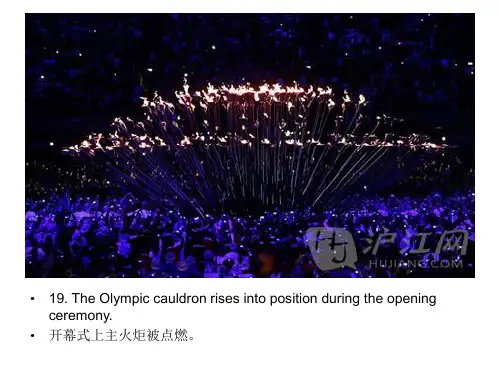
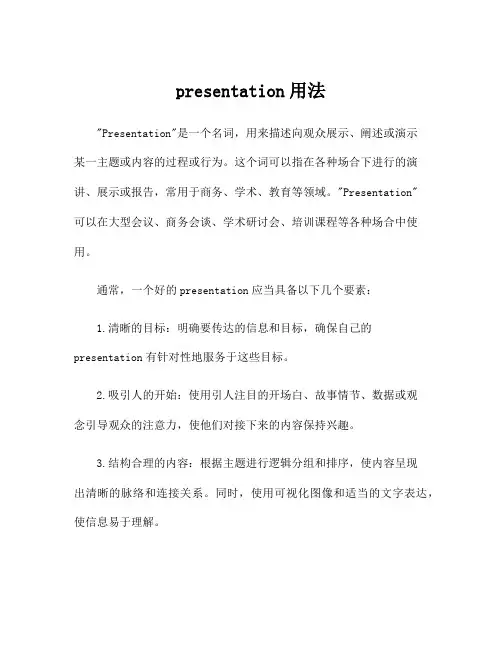
presentation用法"Presentation"是一个名词,用来描述向观众展示、阐述或演示某一主题或内容的过程或行为。
这个词可以指在各种场合下进行的演讲、展示或报告,常用于商务、学术、教育等领域。
"Presentation"可以在大型会议、商务会谈、学术研讨会、培训课程等各种场合中使用。
通常,一个好的presentation应当具备以下几个要素:1.清晰的目标:明确要传达的信息和目标,确保自己的presentation有针对性地服务于这些目标。
2.吸引人的开始:使用引人注目的开场白、故事情节、数据或观念引导观众的注意力,使他们对接下来的内容保持兴趣。
3.结构合理的内容:根据主题进行逻辑分组和排序,使内容呈现出清晰的脉络和连接关系。
同时,使用可视化图像和适当的文字表达,使信息易于理解。
4.生动的展示方式:通过生动有趣的语言、幽默、实例、案例等方式,增加观众对内容的兴趣,使其产生共鸣或思考。
5.持续的参与和互动:通过提问、小测验、讨论、分享经验等方式,促使观众积极参与进来,增加互动和参与感。
6.简明的总结和回顾:在结束前,对内容进行简要回顾,并强调主要要点,让观众更好地记住和理解。
此外,一个成功的presentation还需要适应观众的需求和背景,用简单明了的语言表达观点,掌握好时间,保持自信和自然,并且充分准备和练习,以确保内容的清晰和流畅。
拓展内容:Presentation的形式和工具非常多样化,可以包括使用投影仪、幻灯片、视频、展示板、实物模型、互动软件等多种媒介。
近年来,随着技术的发展,越来越多的人选择使用多媒体和在线平台进行演示,如使用Zoom、Microsoft Teams、Google Slides等视频会议和在线演示工具。
这些工具可以帮助演讲者更直观地呈现内容,增加互动性,并与观众实现远程沟通和协作。
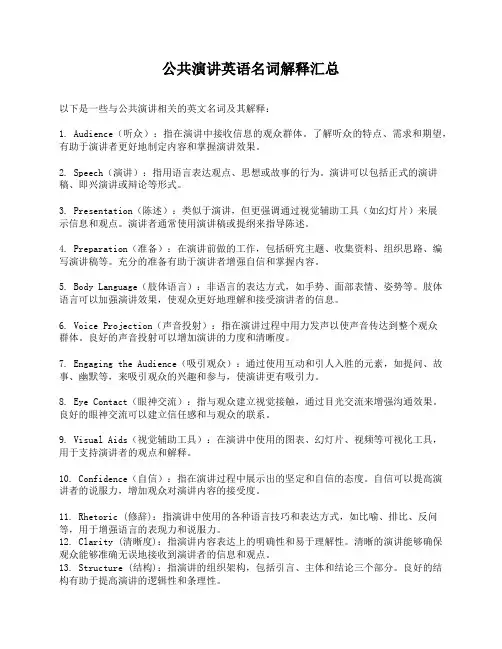
公共演讲英语名词解释汇总以下是一些与公共演讲相关的英文名词及其解释:1. Audience(听众):指在演讲中接收信息的观众群体。
了解听众的特点、需求和期望,有助于演讲者更好地制定内容和掌握演讲效果。
2. Speech(演讲):指用语言表达观点、思想或故事的行为。
演讲可以包括正式的演讲稿、即兴演讲或辩论等形式。
3. Presentation(陈述):类似于演讲,但更强调通过视觉辅助工具(如幻灯片)来展示信息和观点。
演讲者通常使用演讲稿或提纲来指导陈述。
4. Preparation(准备):在演讲前做的工作,包括研究主题、收集资料、组织思路、编写演讲稿等。
充分的准备有助于演讲者增强自信和掌握内容。
5. Body Language(肢体语言):非语言的表达方式,如手势、面部表情、姿势等。
肢体语言可以加强演讲效果,使观众更好地理解和接受演讲者的信息。
6. Voice Projection(声音投射):指在演讲过程中用力发声以使声音传达到整个观众群体。
良好的声音投射可以增加演讲的力度和清晰度。
7. Engaging the Audience(吸引观众):通过使用互动和引人入胜的元素,如提问、故事、幽默等,来吸引观众的兴趣和参与,使演讲更有吸引力。
8. Eye Contact(眼神交流):指与观众建立视觉接触,通过目光交流来增强沟通效果。
良好的眼神交流可以建立信任感和与观众的联系。
9. Visual Aids(视觉辅助工具):在演讲中使用的图表、幻灯片、视频等可视化工具,用于支持演讲者的观点和解释。
10. Confidence(自信):指在演讲过程中展示出的坚定和自信的态度。
自信可以提高演讲者的说服力,增加观众对演讲内容的接受度。
11. Rhetoric (修辞):指演讲中使用的各种语言技巧和表达方式,如比喻、排比、反问等,用于增强语言的表现力和说服力。
12. Clarity (清晰度):指演讲内容表达上的明确性和易于理解性。

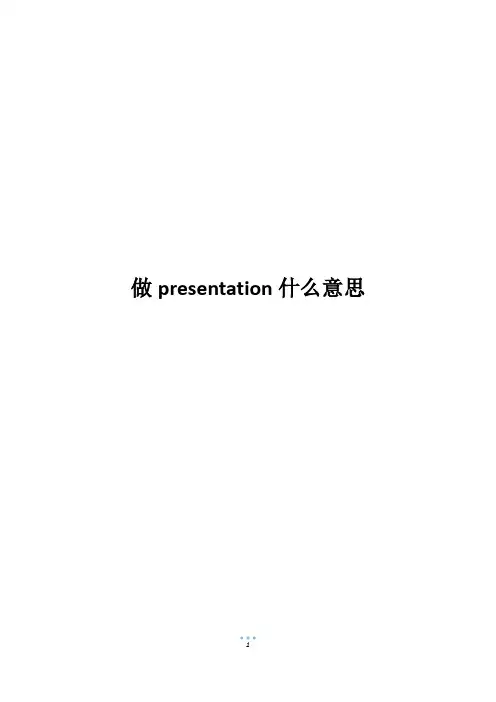
做presentation什么意思做presentation一般是指做演示、做展示的意思。
presentation是一个英语单词,可作名词,中文意思是“提交;授予;颁发;出示;提出(或展示、解释等)的方式;展示会;介绍会;发布会”。
presentation一、读音英[ˌpreznˈteɪʃn] 美[ˌpriːzenˈteɪʃn]二、释义n. 提交;授予;颁发;出示;提出(或展示、解释等)的方式;展示会;介绍会;发布会三、词汇搭配presentation copy 赠送本audible presentation 音响表示data presentation 数据表示compound presentation 复合先露tabular presentation 图表diagrammatic presentation 图示tactile presentation 触觉显示transverse presentation 横产位breech presentation 后肢先产,臀先露...oblique presentation 斜产位presentation attributes 显现属性presentation medium 表示媒体digital presentation 数字显示footling presentation 足先露,脚踏莲花生,...presentation layer 展示层,表示层...directional presentation 方向显示,指向性显示... presentation service 图象业务presentation bill 见票即付汇票...visual presentation 可视图像multimedia presentation system 多媒体表现系统...四、双语例句 1.Banks are under no obligation to accept presentation of documents outside their banking hours.银行在其营业时间外,无接受提交单据的义务。

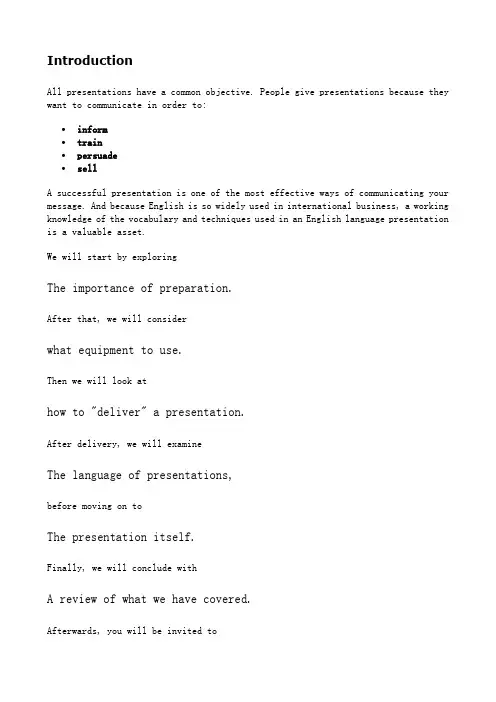
IntroductionAll presentations have a common objective. People give presentations because they want to communicate in order to:∙inform∙train∙persuade∙sellA successful presentation is one of the most effective ways of communicating your message. And because English is so widely used in international business, a working knowledge of the vocabulary and techniques used in an English language presentation is a valuable asset.We will start by exploringThe importance of preparation.After that, we will considerwhat equipment to use.Then we will look athow to "deliver" a presentation.After delivery, we will examineThe language of presentations,before moving on toThe presentation itself.Finally, we will conclude withA review of what we have covered.Afterwards, you will be invited totake a test and ask questions.PreparationCan you name the 3 most important things when giving any presentation?Number 1 is . . .PreparationNumber 2 is . . .Preparation!Number 3 is . . .Preparation!!Preparation is everything!With good preparation and planning you will be totally confident and less nervous. And your audience will feel your confidence. Your audience, too, will be confident. They will be confident in you. And this will give you control. Control of your audience and of your presentation. With control, you will be 'in charge' and your audience will listen positively to your message.ObjectiveBefore you start to prepare a presentation, you should ask yourself: "Why am I making this presentation?" Do you need to inform, to persuade, to train or to sell? Your objective should be clear in your mind. If it is not clear in your mind, it cannot possibly be clear to your audience.Audience"Who am I making this presentation to?" Sometimes this will be obvious, but not always. You should try to inform yourself. How many people? Who are they? Business people? Professional people? Political people? Experts or non-experts? Will it be a small, intimate group of 4 colleagues or a large gathering of 400 competitors? How much do they know already and what will they expect from you?Venue"Where am I making this presentation?" In a small hotel meeting-room or a large conference hall? What facilities and equipment are available? What are the seating arrangements?Time and length"When am I making this presentation and how long will it be?" Will it be 5 minutes or 1 hour? Just before lunch, when your audience will be hungry, or just after lunch, when your audience will be sleepy?MethodHow should I make this presentation?" What approach should you use? Formal or informal? Lots of visual aids or only a few? Will you include some anecdotes and humour for variety?Content"What should I say?" Now you must decide exactly what you want to say. First, you should brainstorm your ideas. You will no doubt discover many ideas that you want to include in your presentation. But you must be selective. You should include only information that is relevant to your audience and your objective. You should exclude all other ideas. You also need to create a title for your presentation (if you have not already been given a title). The title will help you to focus on the subject. And you will prepare your visual aids, if you have decided to use them. But remember, in general, less is better than more (a little is better than a lot). You can always give additional information during the questions after the presentation.StructureA well organised presentation with a clear structure is easier for the audience to follow. It is therefore more effective. You should organise the points you wish to make in a logical order. Most presentations are organised in three parts, followed by questions:NotesWhen you give your presentation, you should be - or appear to be - as spontaneous as possible. You should not read your presentation! You should be so familiar with your subject and with the information that you want to deliver that you do not need to read a text. Reading a text is boring! Reading a text will make your audience go to sleep! So if you don't have a text to read, how can you remember to say everything you need to say? With notes. You can create your own system of notes. Some people make notes on small, A6 cards. Some people write down just the title of each section of their talk. Some people write down keywords to remind them. The notes will give you confidence, but because you will have prepared your presentation fully, you may not even need them!RehearsalRehearsal is a vital part of preparation. You should leave time to practise your presentation two or three times. This will have the following benefits:∙you will become more familiar with what you want to say∙you will identify weaknesses in your presentation∙you will be able to practise difficult pronunciations∙you will be able to check the time that your presentation takes and make any necessary modificationsSo prepare, prepare, prepare! Prepare everything: words, visual aids, timing, equipment. Rehearse your presentation several times and time it. Is it the right length? Are you completely familiar with all your illustrations? Are they in the right order? Do you know who the audience is? How many people? How will you answer difficult questions? Do you know the room? Are you confident about the equipment? When you have answered all these questions, you will be a confident, enthusiastic presenter ready to communicate the subject of your presentation to an eager audience.EquipmentEasily your most important piece of equipment is...YOU! Make sure you're in full working order, and check your personal presentation carefully - if you don't, your audience will!The overhead projector (OHP) displays overheadtransparencies(OHTs or OHPTs). It has several advantagesover the 35mm slide projector:∙it can be used in daylight∙the user can face the audience∙the user can write or draw directly on thetransparency while in useThe whiteboard(more rarely blackboard or greenboard) is a usefuldevice for spontaneous writing - as in brainstorming, for example.For prepared material, the OHP might be more suitable.The duster is used for cleaning the whiteboard. It is essential thatthe duster be clean to start with. You may consider carrying your ownduster just in case.Markers are used for writing on the whiteboard (delible - you canremove the ink) or flipchart (indelible - you cannot remove the ink).They are usually available in blue, red, black and green. Again, it's a good idea to carry a spare set of markers in case you are given some used ones which do not write well."A good workman never blames his tools."The flipchart consists of several leaves of paper that you 'flip' or turnover. Some people prefer the flipchart to the whiteboard, but its use islimited to smaller presentations.The Slide projector - which must be used in adarkened room - adds a certain drama. Some slideprojectors can be synchronised with audio foraudio-visual (AV) presentations. These projectorsare typically used for larger presentations. Themajority take 35mm slides or transparencies (as seen here), but projectors for 6x6cm slides are also available.Transparencies are projected by an overhead projector or a slideprojector onto a screen - in this case a folding screen which can bepacked up and transported.The notebook computer is increasingly being used to display graphicsduring presentations. It is often used in conjunction with an overheadprojector, which actually projects the image from the computer screenonto the wall screen.Handouts are any documents or samples that you 'hand out' or distributeto your audience. Note that it is not usually a good idea to distributehandouts before your presentation. The audience will read the handoutsinstead of listening to you.Delivery'Delivery' refers to the way in which you actually deliver or perform or give your presentation. Delivery is a vital aspect of all presentations. Delivery is at leastas important as content, especially in a multi-cultural context.NervesMost speakers are a little nervous at the beginning of a presentation. So it is normal if you are nervous. The answer is to pay special attention to the beginning of your presentation. First impressions count. This is the time when you establish a rapport with your audience. During this time, try to speak slowly and calmly. You should perhaps learn your introduction by heart. After a few moments, you will relax and gain confidence.Audience RapportYou need to build a warm and friendly relationship with your audience. Enthusiasm is contagious. If you are enthusiastic your audience will be enthusiastic too. And be careful to establish eye contact with each member of your audience. Each person should feel that you are speaking directly to him or her. This means that you must look at each person in turn - in as natural a way as possible. This will also give you the opportunity to detect signs of boredom, disinterest or even disagreement, allowing you to modify your presentation as appropriate.Your objective is to communicate!Body LanguageWhat you do not say is at least as important as what you do say. Your body is speaking to your audience even before you open your mouth. Your clothes, your walk, your glasses, your haircut, your expression - it is from these that your audience forms its first impression as you enter the room. Generally speaking, it is better to stand rather than sit when making a presentation. Be aware of and avoid any repetitive and irritating gestures. Be aware, too, that the movement of your body is one of your methods of control. When you move to or from the whiteboard, for example, you can move fast or slowly, raising or reducing the dynamism within the audience. You can stand very still while talking or you can stroll from side to side. What effect do you think these two different approaches would have on an audience?Cultural ConsiderationsBecause English is so widely used around the world, it is quite possible that many members of your audience will not be native English-speakers. In other words, they will not have an Anglo-Saxon culture. Even within the Anglo-Saxon world, there are many differences in culture. If we hypothetically imagine a German working for an Israeli company making a presentation in English to a Japanese audience in Korea,we can see that there are even more possibilities for cultural misunderstanding. You should try to learn about any particular cultural matters that may affect your audience. This is one reason why preparation for your presentation is so important. Cultural differences can also be seen in body language, which we have just discussed. To a Latin from Southern France or Italy, a presenter who uses his hands and arms when speaking may seem dynamic and friendly. To an Englishman, the same presenter may seem unsure of his words and lacking in self-confidence.Voice qualityIt is, of course, important that your audience be able to hear you clearly throughout your presentation. Remember that if you turn away from your audience, for example towards the whiteboard, you need to speak a little more loudly. In general, you should try to vary your voice. Your voice will then be more interesting for your audience. You can vary your voice in at least three ways:∙speed: you can speak at normal speed, you can speak faster, you can speak more slowly - and you can stop completely! You can pause. This is a very goodtechnique for gaining your audience's attention.∙intonation: you can change the pitch of your voice. You can speak in a high tone. You can speak in a low tone.∙volume: you can speak at normal volume, you can speak loudly and you can speak quietly. Lowering your voice and speaking quietly can again attract youraudience's interest.The important point is not to speak in the same, flat, monotonous voice throughout your presentation - this is the voice that hypnotists use to put their patients' into trance!Visual aidsOf all the information that enters our brains, the vast majority of it enters through the eyes. 80% of what your audience learn during your presentation is learned visually (what they see) and only 20% is learned aurally (what they hear). The significance of this is obvious:∙visual aids are an extremely effective means of communication∙non-native English speakers need not worry so much about spoken English - they can rely more heavily on visual aidsIt is well worth spending time in the creation of good visual aids. But it is equally important not to overload your audience's brains. Keep the information on each visual aid to a minimum - and give your audience time to look at and absorb this information. Remember, your audience have never seen these visual aids before. They need time to study and to understand them. Without understanding there is no communication.Apart from photographs and drawings, some of the most useful visual aids are charts and graphs, like the 3-dimensional ones shown here:Piecharts are circular in shape (like a pie).Barcharts can be vertical (as here) or horizontal.Graphs can rise and fall.Audience ReactionRemain calm and polite if you receive difficult or even hostile questions during your presentation. If you receive particularly awkward questions, you might suggest that the questioners ask their questions after your presentation.LanguageSay what you are going to say,Simplicity and ClarityIf you want your audience to understand your message, your language must be simple and clear.Use short words and short sentences.Do not use jargon, unless you are certain that your audience understands it.In general, talk about concrete facts rather than abstract ideas.Use active verbs instead of passive verbs. Active verbs are much easier to understand. They are much more powerful. Consider these two sentences, which say the same thing:1.Toyota sold two million cars last year.2.Two million cars were sold by Toyota last year.Which is easier to understand? Which is more immediate? Which is more powerful? N°1 is active and N°2 is passive.SignpostingWhen you drive on the roads, you know where you are on those roads. Each road has a name or number. Each town has a name. And each house has a number. If you are at house N° 100, you can go back to N° 50 or forward to N° 150. You can look at the signposts for directions. And you can look at your atlas for the structure of the roads in detail. In other words, it is easy to navigate the roads. You cannot get lost. But when you give a presentation, how can your audience know where they are? How can they know the structure of your presentation? How can they know what is coming next? They know because you tell them. Because you put up signposts for them, at the beginning and all along the route. This technique is called 'signposting' (or'signalling').During your introduction, you should tell your audience what the structure of your presentation will be. You might say something like this:"I'll start by describing the current position in Europe. Then I'll move on to some of the achievements we've made in Asia. After that I'll consider the opportunities we see for further expansion in Africa. Lastly, I'll quickly recap before concluding with some recommendations."A member of the audience can now visualize your presentation like this:He will keep this image in his head during the presentation. He may even write it down. And throughout your presentation, you will put up signposts telling him which point you have reached and where you are going now. When you finish Europe and want to start Asia, you might say:"That's all I have to say about Europe. Let's turn now to Asia."When you have finished Africa and want to sum up, you might say:"Well, we've looked at the three continents Europe, Asia and Africa. I'd like to sum up now."And when you finish summing up and want to give your recommendations, you might say:"What does all this mean for us? Well, firstly I recommend..."The table below lists useful expressions that you can use to signpost the various parts of your presentation.The PresentationMost presentations are divided into 3 main parts (+ questions):As a general rule in communication, repetition is valuable. In presentations, there is a golden rule about repetition:1.Say what you are going to say,2.say it,3.then say what you have just said.In other words, use the three parts of your presentation to reinforce your message. In the introduction, you tell your audience what your message is going to be. In the body, you tell your audience your real message. In the conclusion, you summarize what your message was.We will now consider each of these parts in more detail.IntroductionThe introduction is a very important - perhaps the most important - part of your presentation. This is the first impression that your audience have of you. You should concentrate on getting your introduction right. You should use the introduction to:1.welcome your audience2.introduce your subject3.outline the structure of your presentation4.give instructions about questionsThe following table shows examples of language for each of these functions. You may need to modify the language as appropriate.BodyThe body is the 'real' presentation. If the introduction was well prepared and delivered, you will now be 'in control'. You will be relaxed and confident.The body should be well structured, divided up logically, with plenty of carefully spaced visuals.Remember these key points while delivering the body of your presentation: ∙do not hurry∙be enthusiastic∙give time on visuals∙maintain eye contact∙modulate your voice∙look friendly∙keep to your structure∙use your notes∙signpost throughout∙remain polite when dealing with difficult questionsConclusionUse the conclusion to:1.Sum up2.(Give recommendations if appropriate)3.Thank your audience4.Invite questionsThe following table shows examples of language for each of these functions. You may need to modify the language as appropriate.QuestionsQuestions are a good opportunity for you to interact with your audience. It may be helpful for you to try to predict what questions will be asked so that you can prepare your response in advance. You may wish to accept questions at any time during your presentation, or to keep a time for questions after your presentation. Normally, it's your decision, and you should make it clear during the introduction. Be polite with all questioners, even if they ask difficult questions. They are showing interest in what you have to say and they deserve attention. Sometimes you can reformulate aquestion. Or answer the question with another question. Or even ask for comment from the rest of the audience.Review...then say what you have just said.In this seminar, you have learned:∙to allow plenty of time for preparation∙to ask the all-important question-words, why? who? where? when? how? and what?∙to structure your presentation into introduction, body, conclusion and questions∙to write notes based on keywords∙to rehearse your presentation several times and modify it as necessary ∙to select the right equipment for the job∙to use equipment effectively∙to make use of clear, powerful visual aids that do not overload your audience ∙to use clear, simple language, avoiding jargon∙to use active verbs and concrete facts∙to explain the structure of your presentation at the beginning so that your listeners know what to expect∙to link each section of your presentation∙to signpost your presentation from beginning to end so that your listeners know where they are∙to say what you are going to say, say it, and say what you have just said ∙to overcome your nerves∙to establish audience rapport∙to be aware of your body language∙to understand cultural differences∙to control the quality of your voice∙to maintain interest by varying the speed, volume and pitch of your voice ∙to deal with listeners' questions politely∙to respond to your audience positively。
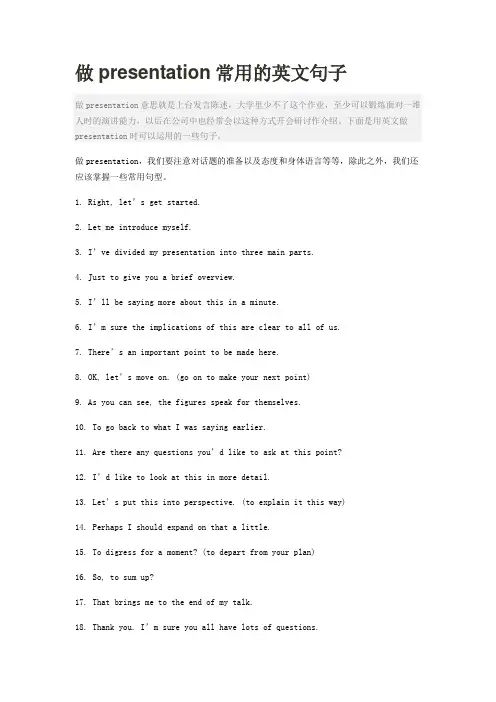
做presentation常用的英文句子做presentation意思就是上台发言陈述,大学里少不了这个作业,至少可以锻炼面对一堆人时的演讲能力,以后在公司中也经常会以这种方式开会研讨作介绍。
下面是用英文做presentation时可以运用的一些句子。
做presentation,我们要注意对话题的准备以及态度和身体语言等等,除此之外,我们还应该掌握一些常用句型。
1. Right, let’s get started.2. Let me introduce myself.3. I’ve divide d my presentation into three main parts.4. Just to give you a brief overview.5. I’ll be saying more about this in a minute.6. I’m sure the implications of this are clear to all of us.7. There’s an important point to be made here.8. OK, let’s move on. (go on to make your next point)9. As you can see, the figures speak for themselves.10. To go back to what I was saying earlier.11. Are there any questions you’d like to ask at this point?12. I’d like to look at this in more detail.13. Let’s put this i nto perspective. (to explain it this way)14. Perhaps I should expand on that a little.15. To digress for a moment? (to depart from your plan)16. So, to sum up?17. That brings me to the end of my talk.18. Thank you. I’m sure you all have lots of questi ons.。
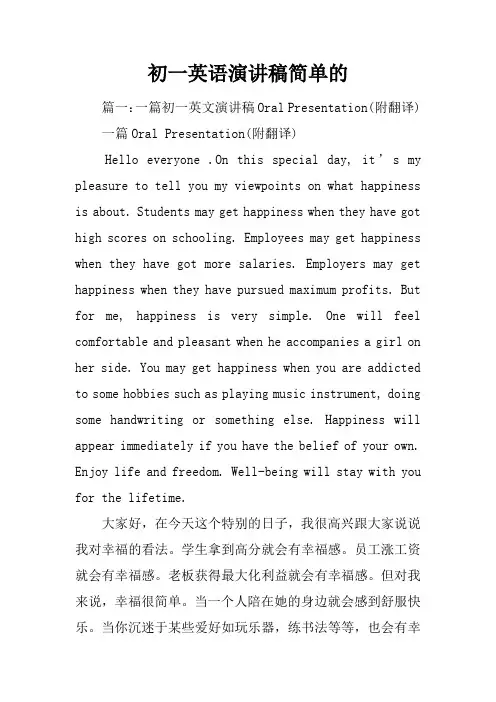
初一英语演讲稿简单的篇一:一篇初一英文演讲稿Oral Presentation(附翻译) 一篇Oral Presentation(附翻译)Hello everyone .On this special day, it’s my pleasure to tell you my viewpoints on what happiness is about. Students may get happiness when they have got high scores on schooling. Employees may get happiness when they have got more salaries. Employers may get happiness when they have pursued maximum profits. But for me, happiness is very simple. One will feel comfortable and pleasant when he accompanies a girl on her side. You may get happiness when you are addicted to some hobbies such as playing music instrument, doing some handwriting or something else. Happiness will appear immediately if you have the belief of your own. Enjoy life and freedom. Well-being will stay with you for the lifetime.大家好,在今天这个特别的日子,我很高兴跟大家说说我对幸福的看法。
学生拿到高分就会有幸福感。
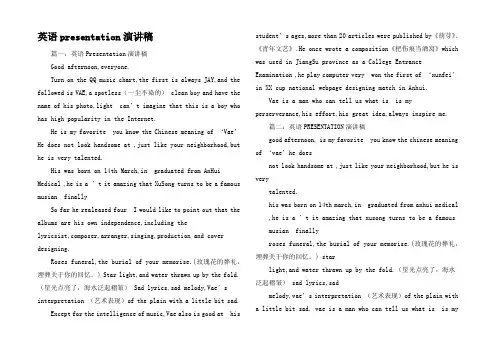
英语presentation演讲稿篇一:英语Presentation演讲稿Good afternoon,everyone.Turn on the QQ music chart,the first is always JAY,and the followed is VAE,a spotless(一尘不染的) clean boy and have the name of his photo,light can’t imagine that this is a boy who has high popularity in the Internet.He is my favorite you know the Chinese meaning of ‘Vae’He does not look handsome at ,just like your neighborhood,but he is very talented.His was born on 14th March,in graduated from AnHui Medical ,he is a ’t it amazing that XuSong turns to be a famous musian finallySo far he realeased four I would like to point out that the albums are his own independence,including thelyricsist,composer,arranger,singing,production and cover designing.Roses funeral,the burial of your memorise.(玫瑰花的葬礼,埋葬关于你的回忆。
) Star light,and water thrawn up by the fold.(星光点亮了,海水泛起褶皱) Sad lyrics,sad melody,Vae’s interpretation (艺术表现)of the plain with a little bit sad.Except for the intelligence of music,Vae also is good at his student’s ages,more than 20 articles were published by《萌芽》、《青年文艺》.He once wrote a composition《把伤痕当酒窝》which was used in JiangSu province as a College Entrance Examination ,he play computer very won the first of ‘xunfei’in XX cup national webpage designing match in Anhui.Vae is a man who can tell us what is is my perserverance,his effort,his great idea,always inspire me.篇二:英语PRESENTATION演讲稿good afternoon, is my favorite you know the chinese meaning of ‘vae’he doesnot look handsome at ,just like your neighborhood,but he is verytalented.his was born on 14th march,in graduated from anhui medical ,he is a ’t it amazing that xusong turns to be a famous musian finallyroses funeral,the burial of your memorise.(玫瑰花的葬礼,埋葬关于你的回忆。
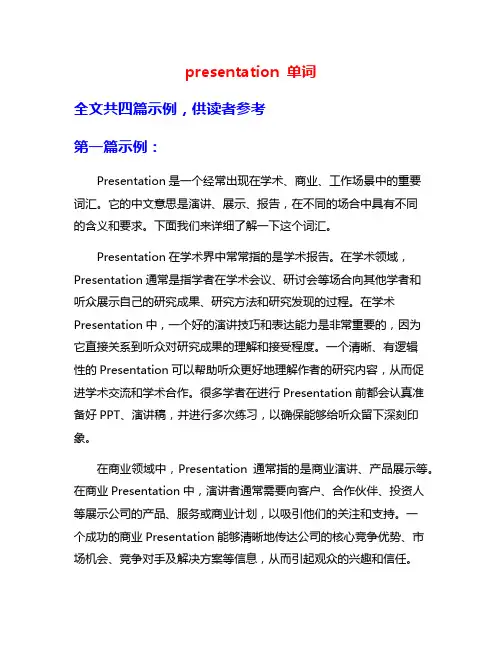
presentation 单词全文共四篇示例,供读者参考第一篇示例:Presentation是一个经常出现在学术、商业、工作场景中的重要词汇。
它的中文意思是演讲、展示、报告,在不同的场合中具有不同的含义和要求。
下面我们来详细了解一下这个词汇。
Presentation在学术界中常常指的是学术报告。
在学术领域,Presentation通常是指学者在学术会议、研讨会等场合向其他学者和听众展示自己的研究成果、研究方法和研究发现的过程。
在学术Presentation中,一个好的演讲技巧和表达能力是非常重要的,因为它直接关系到听众对研究成果的理解和接受程度。
一个清晰、有逻辑性的Presentation可以帮助听众更好地理解作者的研究内容,从而促进学术交流和学术合作。
很多学者在进行Presentation前都会认真准备好PPT、演讲稿,并进行多次练习,以确保能够给听众留下深刻印象。
在商业领域中,Presentation通常指的是商业演讲、产品展示等。
在商业Presentation中,演讲者通常需要向客户、合作伙伴、投资人等展示公司的产品、服务或商业计划,以吸引他们的关注和支持。
一个成功的商业Presentation能够清晰地传达公司的核心竞争优势、市场机会、竞争对手及解决方案等信息,从而引起观众的兴趣和信任。
很多企业会对员工进行相关的演讲技巧培训,以提高他们的演讲能力和表达能力,使他们能够更好地向外界展示公司的实力和潜力。
在工作场景中,Presentation也是非常常见的。
无论是在公司内部开会、向领导汇报工作成果、向同事分享经验,还是在外展示公司形象、推销产品,Presentation都是必不可少的。
一个好的Presentation能够帮助同事更好地理解你的工作内容和思路,促进团队合作和沟通;而一个成功的外部Presentation能够帮助公司留下良好的印象,促进业务的拓展和发展。
无论是在工作中还是在生活中,都需要具备一定的演讲能力和表达能力,以应对各种各样的场合和要求。
presentation的用法和例句
presentation是一个英语单词,意思是“展示”、“报告”或“陈述”。
在商务或学术领域,它通常用于描述一个准备好的讲稿或报告,其中包含有关特定主题的信息和数据。
以下是一些使用presentation的例句:
1. I am giving a presentation on my project tomorrow.
明天我要做关于我的项目的报告。
2. The presentation was very well received by the audience.
这个报告得到了听众的热烈反响。
3. The company president will be making a presentation to the shareholders.
公司总裁将向股东们作报告。
4. The presentation included a lot of visual aids, such as slides and graphs.
这个报告中包含许多视觉辅助工具,例如幻灯片和图表。
5. The sales team will be giving a presentation on our new product line. 销售团队将为我们新产品系列作展示。
1。
演讲稿的英文名词有哪些
英文中常用的演讲稿相关名词包括:
1. Speech: 演讲,指一段口头表达意见、主张或演讲者的思想观点的话语。
2. Address: 演讲,指正式或庄重的演讲,通常由政府或重要人物发表。
3. Presentation: 演示,展示,指通过口头、视觉或其他方式向观众呈现信息或主题。
4. Talk: 讲话,指简短的演讲,可以用于不正式的场合。
5. Lecture: 讲座,指有组织的演讲,旨在向听众传授新知识或提出论题。
6. Keynote: 主旨演讲,指开场或重要场合的演讲,通常具有引导议题、振奋人心的作用。
7. Addressing: 演讲或致辞,指通过正式发言向公众或听众提出观点或呼吁。
8. Oratory: 雄辩术,指通过演讲的艺术来影响听众,特指修辞华丽和有力的讲演风格。
9. Public speaking: 公开演讲,指向公众或大型听众发表演讲的能力。
10. Rhetoric:修辞学,指通过语言手法和表达方式影响听众的技巧和艺术。
英文presentation一分钟范文全文共3篇示例,供读者参考篇1Good morning/afternoon/evening, everyone. Today I am here to give a brief presentation on [topic].First of all, let me introduce myself. My name is [Your Name] and I am a [Your Position] at [Your Company/Organization]. I have been working in this field for [X years] and I am excited to share some key insights with you all today.The purpose of this presentation is to [state the objective - inform, persuade, educate, etc.]. I will be covering [list the main points/topics you will be discussing].To start off, let's take a look at [begin with the first main point/topic]. This is important because [explain why thispoint/topic is relevant/significant].Moving on to the next point/topic, [transition to the next main point/topic]. This ties in with the previous point because [explain how they are connected or build upon each other].Finally, we will touch upon [conclude with the final main point/topic]. This is crucial because [emphasize the importance or impact of this point/topic].In conclusion, [summarize the key points/topics discussed]. I hope that this presentation has provided you with a better understanding of [topic] and has sparked some interesting discussions and ideas.Thank you for your time and attention. I am happy to answer any questions you may have. Have a great day/evening!篇2Good afternoon everyone,Today I am here to give a brief presentation on the topic of artificial intelligence. Artificial intelligence, or AI, is a rapidly growing field that holds immense potential to revolutionize various industries and aspects of our daily lives.AI is the simulation of human intelligence processes by machines, especially computer systems. These processes include learning, reasoning, problem solving, perception, and language understanding. One of the key applications of AI is machine learning, where algorithms are designed to learn from and make predictions or decisions based on data.In recent years, AI has made significant advancements in areas such as healthcare, finance, and transportation. For example, AI-powered systems are being used to analyze medical images and diagnose diseases more accurately and quickly than human doctors. In finance, AI algorithms can analyze vast amounts of data to predict market trends and make investment decisions. In transportation, AI is being used to developself-driving cars that can navigate roads and traffic with minimal human intervention.Despite its many benefits, AI also raises concerns about issues such as data privacy, job displacement, and ethical considerations. As AI continues to evolve and become more integrated into society, it is important for us to consider the implications and ensure that it is used responsibly and ethically.In conclusion, artificial intelligence is a powerful technology with the potential to transform the way we live and work. By understanding its capabilities and limitations, we can harness the benefits of AI while addressing the challenges it presents. Thank you for listening.篇3Good afternoon, ladies and gentlemen.Today, I am here to present to you an overview of our company's latest products and services.First and foremost, let me introduce our new range ofeco-friendly household products. With the increasing global concern for the environment, our company has taken the initiative to develop a line of products that are made from sustainable materials and are biodegradable. These products not only help reduce our carbon footprint but also contribute to a healthier environment for future generations.Moving on, we have also introduced a new service that focuses on enhancing customer satisfaction. Our customer service team has been trained to provide personalized assistance to every client, ensuring that their needs are met promptly and efficiently. This commitment to customer satisfaction has resulted in a significant increase in our customer retention rates and has garnered positive feedback from our clients.Furthermore, I am pleased to announce the launch of our new digital marketing campaign. By leveraging the latest technology and data analytics, we have been able to target our audience with precision and relevance, resulting in a higher conversion rate and return on investment. The results speak forthemselves, as we have seen a sharp increase in website traffic and online sales.In conclusion, our company remains committed to innovation and excellence in all that we do. We will continue to strive for excellence in our products and services, always keeping the needs and interests of our customers at the forefront. Thank you for your time and attention.That concludes my presentation. Thank you.。
presentation翻译中文presentation翻译中文presentation的汉语意思是“演示”或“表演”,引申出的更广泛的意思是“表达”。
它可以用于各种场合,如商业、学术、社会和其他场合。
因此,presentation往往被认为是一种重要而强大的沟通工具。
在商业场合,presentation可以被用来向客户展示公司的服务或产品,也可以用来向合作伙伴展示一项新的商业计划或提案。
在学术场合,presentation则可以用来向教授或课堂上的其他学生展示一篇论文或其他研究成果。
在社会场合,presentation可以被用来向外界展示一个社区或社会组织的价值观以及未来发展方向。
在任何场合中,presentation都可以发挥其重要作用。
首先,它能够帮助沟通者更好地理解和表达所要传达的信息,让观众更清楚明白这些信息。
其次,presentation也可以帮助沟通者更好地引起观众的兴趣,使他们更有可能接受所传达的信息。
最后,presentation 还可以帮助沟通者更好地让观众记住所传达的信息,从而使之更有可能被采纳。
对于想要将信息传达给他人的人来说,presentation 的重要性不言而喻。
因此,准备presentation时,应该格外小心,以便将自己的想法最大限度地表达出来。
其中,首先要考虑的是目标受众,即要把自己的信息传达给谁,然后确定presentation的内容和形式,以及如何才能最好地表达自己的想法。
除此之外,在准备presentation时,还要考虑presentation的结构,比如是否应该按照某种特定的模式(如开场、主题、结尾)去构建,以及是否应该加入图表和图片等图形元素,以增加观众的视觉体验。
此外,在准备presentation时,还要考虑如何利用声音、动作和其他多媒体元素来提高表达效果,这样才能使观众对所展示的信息有更深刻的理解。
总之,presentation是一种重要而强大的沟通工具,无论是在商业、学术、社会还是其他场合,都可以发挥其重要作用。